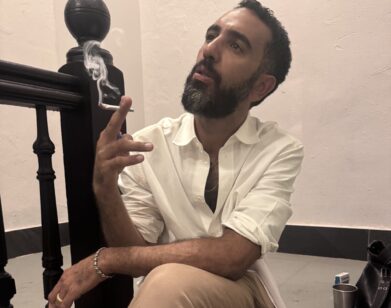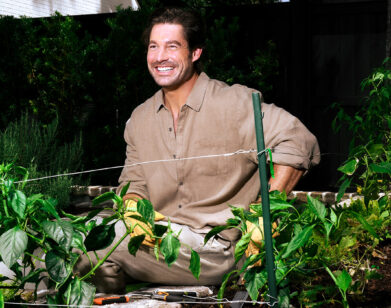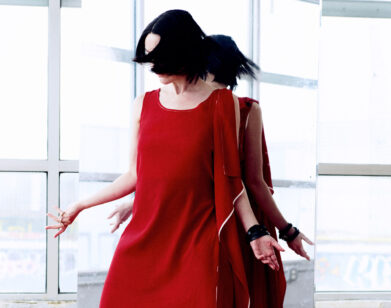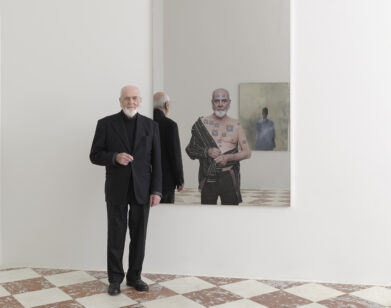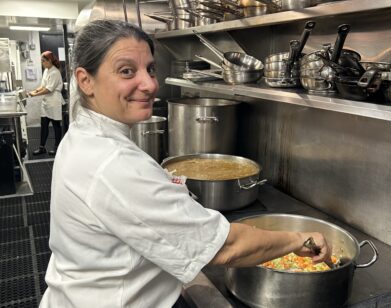lesson
The New York Artist Kinlaw Teaches a Vocal and Body Movement Lesson
The Brooklyn-based artist Sarah Kinlaw is exploring new territory with their latest piece of work, which has taken the form of a debut album. The Tipping Scale is a pop-meets-electronica reflection on the beauty of the ordinary. Kinlaw is mainly known for their work as a multimedia artist and choreographer. For the queer artist, movement and fluidity are a major part of life and art. In that same spirit, Kinlaw spoke with Interview about the inspirations behind their album The Tipping Scale and shares a vocal and body movement lesson that they consider will help center and open the mind. In Kinlaw’s own words: “Be curious.”
———
ERNESTO MACIAS: Tell me about your new album. What were the inspirations behind the music?
KINLAW: Being in communication with others regarding change, grieving, emotions–that kind of synthesis, it’s all that I want out of life. I don’t feel like I am right. I don’t feel like I am important in the ways you might suspect, given how art is presented these days. Above all else, I feel this deep magnetic pull toward curiosity and desire to talk with people and work things out alongside them. Maybe my inspiration was to have some company? To not feel isolated in the things I was going through? I wanted to experiment with the framing of memories by weaving them together with pop music, which is frequently discussed and often pretty accessible.
I tend to feel explosive things and immediately want to externalize them, talk about them, see them take shape in another way, and you know, it’s gotten me into trouble in the past, but it’s a process. Coupling this explosiveness with a sense of humor from time to time can also be an important way for me to stabilize and feel stability. I’m still learning how to have a healthy relationship with my thoughts and feelings, and I am often thinking about how inspiration and sustainability can be hand in hand.
MACIAS: Why did you choose to do a vocal and body movement lesson for us? What is the value in learning about this?
KINLAW: It is an obvious choice when I think about what I want out of communication surrounding art and the kinds of discussions that interest me. I have a strong distaste for how some artists are pedestalled, and others aren’t, as well as our Western idea of “genius.” It puts too much pressure on artists and obstructs a natural way of creative thinking. I like sharing tools that start a personal investigation and conversation, and I love how these investigations don’t necessarily have answers but more questions! When I think about life and my zoomed-out goals, I feel like this constant pursuit to question is one of the most extraordinary things you can experience. It makes you a good listener, a good friend, an expansive thinker, part of a community.
You know, this question also reminds me a little bit about one of my favorite books called Choreographing Empathy written by Susan Leigh Foster. She was this incredible choreographer and scholar. Right now, the thing that is coming to mind is kinesthetic sympathy, which believes that viewers and listeners actively partake in a performance experience, even when they are watching from the audience. It discusses scientific theories, like the mirror neuron theory, which, to paraphrase, functions as a portal for empathy. I guess the workshops are a way to take this relationship further, and, in addition to sharing performance and songs, I think it’s cool to offer up a framework for others to experiment and play.
This kind of physiological and emotional interplay is super nonlinear and empowering. To go back to your question in terms of value, well, I don’t know if I can answer that outright, but I can say it doesn’t hurt to play. I share tools and teach because I think information sharing and the passing of tools, particularly through art, have immense value. I continue sharing tools to honor the educators who had come before me.
MACIAS: How has this impacted your life?
KINLAW: Taking myself out of situations where I feel I need to “present” or “perform” has been the most valuable thing. Art is so far-reaching, and creativity has so many parts. This is obvious, but I think it’s a cool reminder to think about the different ways you can interact with people outside of the work you produce, even if you are being asked to perform for them or entertain them. You are more than what you make, and I sometimes think it’s better to flip the mirror in a sense and offer others the chance to synthesize and perform, even if they might have thought they wanted you to do it, instead.
MACIAS: What is your hope when people listen to The Tipping Scale?
KINLAW: I hope it reminds people that they can carve out the littlest bit of space between the things they might be feeling, with the constant reminder that situations evolve, change– that we change. Also, there are ways, if they choose, to externalize some of our experiences, and that these things we make can stay private, they can be public, they can be discussed, but that ultimately, you are your own boss always, and no matter what choices you make surrounding them, you will still be that boss.
———
Singing Isn’t Always Pretty: Kinlaw’s Step-by-Step Guide to Vocal and Body Movement
Step 1: Pause
Would you like to interface with your screen differently? Even if for a few minutes? I’m not a teacher. I’m not a know-it-all. I’m just a room. You are welcome to join.
Step 2: Consider
The ways some of us speak and make gestures in our everyday. This workshop considers that that same link between the ways we move and the ways we make sound can be used to help us play with the voice.
Step 3: Align
Whether you are sitting, standing, on a phone, with a computer– line up your head. Lift it, become taller, and in some cases, you might bring it back slightly. Consider how nice it is to have an open pathway to send the air from your diaphragm to the resonant space inside your head.
Step 4: Link
Experiment with the conductor’s hands. Allow the gestures and the quality of the ways you move affect the quality of your voice. How would it feel to let your hands sing out the lines? What changes? Can you further connect this idea of letting your physical body inform how you freely and playfully vocalize sound?
Step 5: Trill
Now see how much breath support you can add to your link! Lip trills are a good way to get a sense of how much air you use behind your vocalizations. Remember, if it’s kind of motorboat sounding, you probably need a more solid airflow.
Step 6: Enjoy
Enjoy this process, and don’t judge yourself. Use tools to find new information, but remember, there is no right or wrong way to be creative, only new ways to be curious.
———



